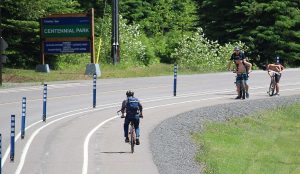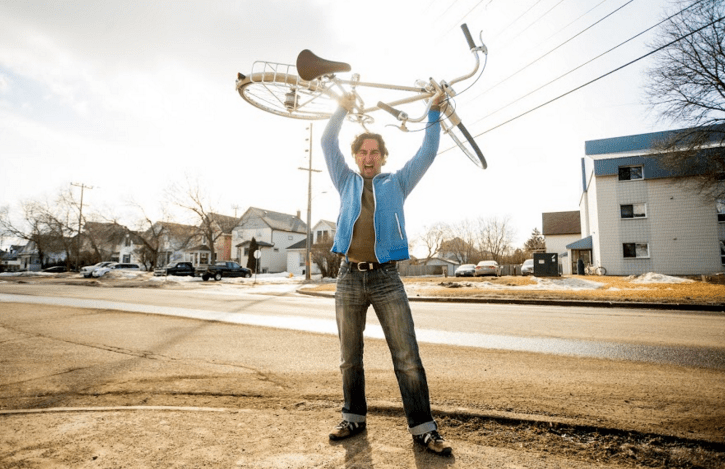By Kirsti Salmi, with Dean Stamler
What does Thunder Bay driving look like to a cyclist?
Whatever my opinion is, it will be challenged within some parts of the cycling community. That said, I think the only reasonable perspective to answer that question is by keeping in mind the most vulnerable road users—children.
We constantly admonish our children to “stop at the intersection,” or “look to your left.” Kids see mom and dad cycling and they want to join, but then the awful reality of our unintuitive infrastructure and careless drivers rears its head. “Let me teach you how unsafe this world is,” is more common now than “enjoy exploring.”
A better question, maybe, is “what does Thunder Bay cycling look like to a non-cyclist?” The answer is often “subjectively not worth it.” Once we make cycling a reasonable mode of transport then Thunder Bay will have almost no issues with road safety.
What is the worst encounter you’ve had while cycling on the road?
I was heading west on Empire Ave two years ago and moved to the centre line (which isn’t painted) to turn left on Brown Street at the Mary J. L. Black library. In Ontario, cyclists are required to behave like cars, and that means merging into turning positions. There was not enough space for the blue pickup behind me to squeeze right to pass (which is exactly what it would’ve been with a car as well). But the driver made space, barely missed me at a high rate of speed, wound down the window, and said “Fuck you, the road is meant for cars.”
Do you think the inclusion of bike lanes has improved road conditions and safety for cyclists?
I know it has. The data says so. Every street with added bicycle lanes has become safer. That doesn’t mean I agree with the way they’re designed all of the time. They need to be designed to engineer bad behaviours by both drivers and cyclists out of the system. Safety-priority engineering is best encapsulated in Vision Zero—a platform where Sweden and dozens of other jurisdictions have half as many traffic fatalities per capita as Canada. Sweden in particular is shooting for 0 by 2020.
Do you have any pointers so that motorists can share the road more effectively?
A simple rule would be give the bike the same space you give a car—that probably means changing lanes or executing a pass into oncoming traffic, which is perfectly legal.
Distracted driving kills more people in Ontario than drunk driving now. I’ll be stopped at an intersection in the bike lane and someone will pull up next to me with a phone, screen on, in their lap, like every fourth car. It’s rampant. That wouldn’t be a problem if you were on a bicycle, or walking, and the only person at risk of reaching a fatal end was yourself. If you are a person who uses their phone at all, write a little note to yourself and tape it to the steering wheel. Make it say “My addiction will make me a murderer, but I choose to overcome my addiction.” Then put your phone away while you drive. If you’re a slave to notifications then you have a problem.
Is there any message you’d like to give Thunder Bay drivers?
Driving is a privilege. The roads are not paid for any more by you than they are by a cyclist, a pedestrian, or a transit rider because roads are funded with property taxes. I pay for roads the same amount as you by paying my property taxes. Every time I ride my bike the road wears out less, which means cyclists actually help subsidize drivers.
As a person who rides a bike, I hate sharing space with cars unless we’re both moving at a relaxed pace (like 20 km/h tops). I know drivers hate it too. Tell your councillor you want bikes off the road and into a cycle track—a safe, separated place next to the sidewalk engineered for bikes. Then we can meet at the ice cream shop and give each other high-fives.
 In an innovative approach, Stamler suggests applying the hierarchy of hazard control to road rules. If you’re not familiar, the hierarchy of hazard control is a standard model of workplace safety. They’re listed in decreasing order of effectiveness.
In an innovative approach, Stamler suggests applying the hierarchy of hazard control to road rules. If you’re not familiar, the hierarchy of hazard control is a standard model of workplace safety. They’re listed in decreasing order of effectiveness.
Elimination: Were there no cars the number of road fatalities would drop precipitously. Is it extreme to eliminate cars in Thunder Bay? Yes. Should we? Probably not.
Substitution: Could we replace cars with something else—better transit, walking, bikes? Data says that the single biggest determination of how safe a cyclist will be on the road is the number of other cyclists. So how do we get more people onto bikes? That would be …
Engineering: Make cycle tracks—bike lanes cars physically cannot drive into. In every place cycle tracks are built, people use them and cycling increases: Calgary, Ottawa, Toronto, Saskatoon, Winnipeg, Montreal. Make protected intersections with separate signal timings where traffic is high. On quiet streets, reduce speed limits low—30 km/h or less, and ensure drivers expect cyclists to mix with them on those streets.
Administrative Controls: Your “rules of the road.” Establish and adhere to motoring laws.
Personal Protective Equipment: It’s important to wear your helmet, but it is not going to save you when you get right-hooked by a truck. In fact, there is growing evidence that suggests some drivers are more aggressive around cyclists wearing helmets than those not wearing them.















